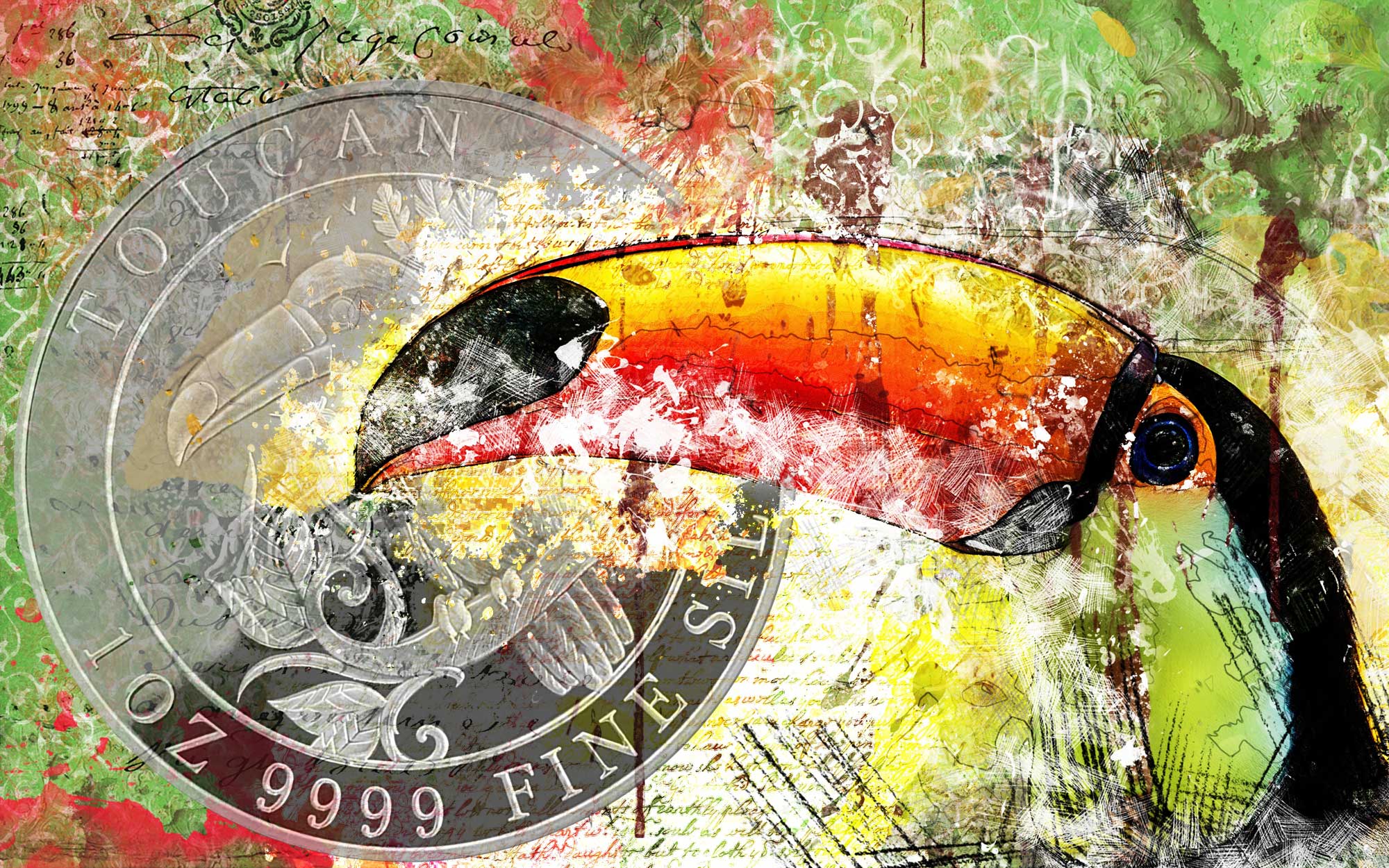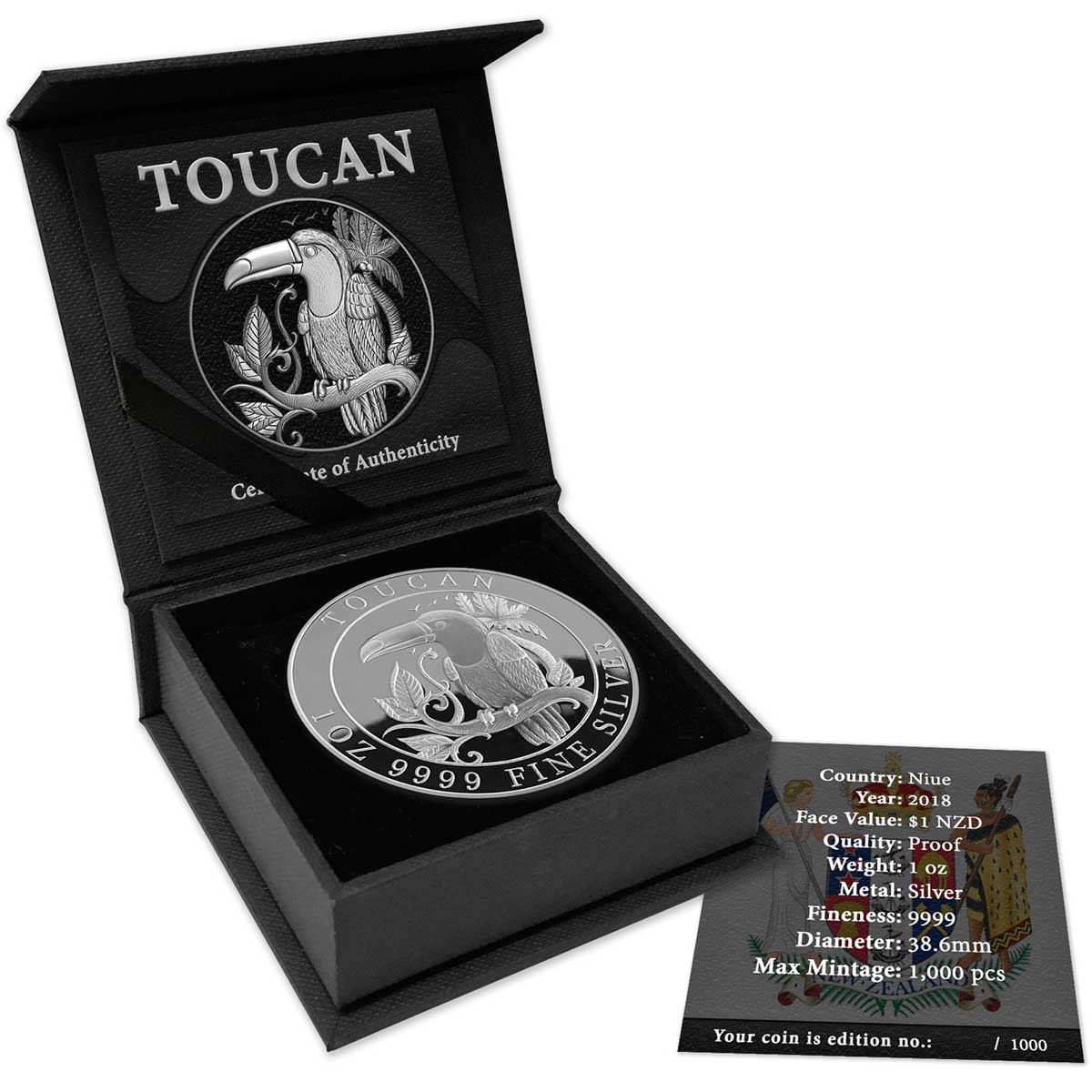The beautiful and distinctive South American Toucan appears in style on the European Mints latest coin
Bright, colourful, loud and in Brazil. No, it’s not the Mardi Gras, it’s the Toucan. One of the most amazing looking of all birds, the Toucan doesn’t actually have a big presence in modern numismatics – quite strange given the proliferation of colour that has entered the market over the last couple of decades. Photo-realistic colour isn’t always the best way to depict something on a coin anyway, and that certainly seems to be the case with this coin.
The design is very cool. Rather than adapt a photograph as so many others have done, this coin uses a depiction that perhaps has shades of the work of John James Audobon. The stylised flora in the background frames the bird perfectly. The reverse-face inscriptions are limited to the title and composition, with everything else surrounding the Ian Rank Broadley effigy of Queen Elizabeth II, as you would expect of a Niue issue.
Produced by the European Mint, there are only a thousand of these one-ounce 0.9999 proof silver being struck. The presentation looks good. The box is similar in style to those used by the Mint of Poland for their own, and for Narodowy Bank issues, and we like those. A serialised certificate of authenticity is included. Priced in the €65-70 range, it’s reasonably priced and the first in a new annual series of proof coins. Next years Toucan coin will have a different design and with a bird this distinctive, there’s a huge potential for this to grow into an attractive set. Available now from European Mint direct and from several of our sponsors.
THE TOUCAN (Ramphastos toco)
The toco toucan, also known as the common or giant toucan, is the biggest and most iconic member of the Toucan family. It is found throughout a large part of central and eastern South America. It is essentially a non-forest species. It can be found in a wide range of semi-open habitats such as woodland, savanna and other open habitats with scattered trees, Cerrado, plantations, forest-edge, and even wooded gardens. It is mainly a species of lowlands, but occurs up to 1,750 m (5,740 ft) near the Andes in Bolivia.
The toco toucan has a striking plumage with a mainly black body, a white throat, chest and uppertail-coverts, and red undertail-coverts. What appears to be a blue iris is actually thin blue skin around the eye. This blue skin is surrounded by another ring of bare, orange skin. The most noticeable feature, however, is its huge bill, which measures from 15.8 to 23 cm in length, which is yellow-orange, tending to deeper reddish-orange on its lower sections and culmen, and with a black base and large spot on the tip. It looks heavy, but as in other toucans it is relatively light because the inside largely is hollow. The tongue is nearly as long as the bill and very flat.
This species is the largest toucan and ranges from 55–65 cm in length, with a weight range of 500 to 876 g, the males being the heavier of the sexes. Other than the size difference, there is no external differences between the sexes. Its voice consists of a deep, coarse croaking, often repeated every few seconds. It also has a rattling call and will bill-clack. The bill is the largest relative to body size of all birds providing 30 to 50% of its body surface area. Charles Darwin suggested it was a sexual ornament: “toucans may owe the enormous size of their beaks to sexual selection, for the sake of displaying the diversified and vivid stripes of colour with which these organs are ornamented“. Further suggestions have included aid in peeling fruit, intimidating other birds when robbing their nests, social selection related to defense of territory, and as a visual warning. The bill has the ability to modify blood flow and so regulate heat distribution in the bird, allowing it to use its bill as a thermal radiator. In its capacity to remove body heat the bill is comparable to that of elephant ears.
The toco toucan eats fruit using its bill to pluck them from trees, but also insects, frogs, small reptiles, small birds and their eggs and nestlings. The long bill is useful for reaching things that otherwise would be out-of-reach. It is typically seen in pairs or small groups. In flight it alternates between a burst of rapid flaps with the relatively short, rounded wings, and gliding. Nesting is seasonal, but timing differs between regions. The nest is typically placed high in a tree and consists of a cavity, at least part of which is excavated by the parent birds themselves. It has also been recorded nesting in holes in earth-banks and terrestrial termite-nests. Their reproduction cycle is annual. The female usually lays two to four eggs a few days after mating. The eggs are incubated by both sexes and hatch after 17–18 days. These birds are very protective of themselves and their chicks.
Fortunately, the Toucan is doing fine in the wild and is listed of Least Concern by BirdLife International.
| SPECIFICATION | |
| DENOMINATION | $1 New Zealand (Niue) |
| COMPOSITION | 0.9999 silver |
| WEIGHT | 31.1 grams |
| DIMENSIONS | 38.6 mm |
| FINISH | Proof |
| MODIFICATIONS | None |
| MINTAGE | 1,000 |
| BOX / COA | Yes / Yes |







Leave A Comment